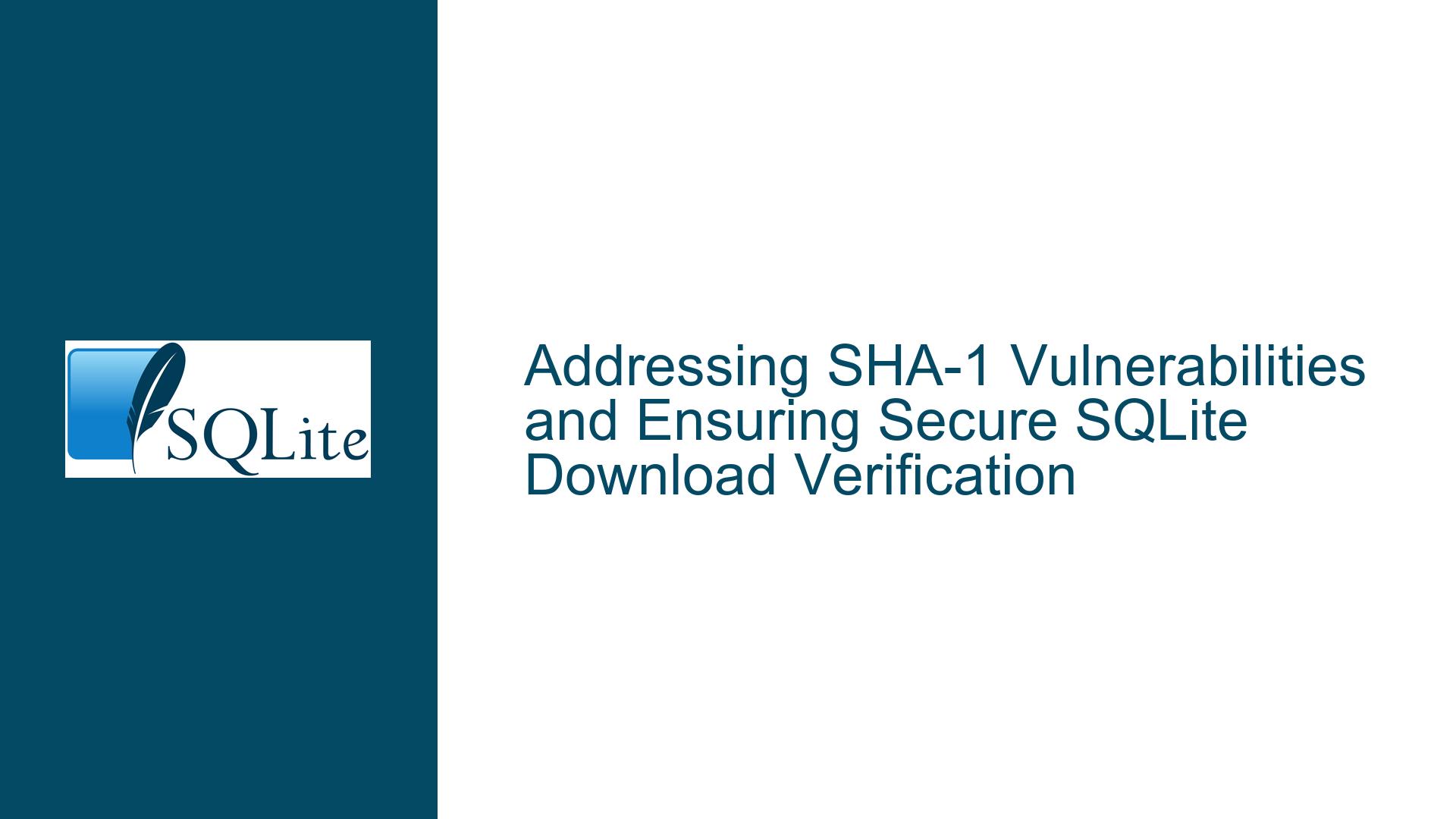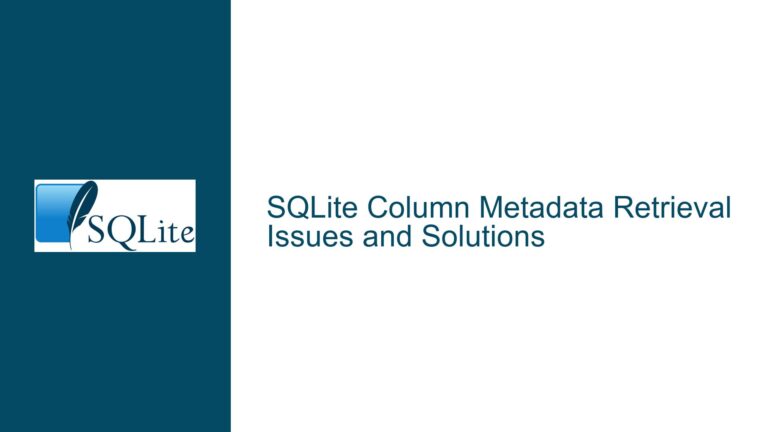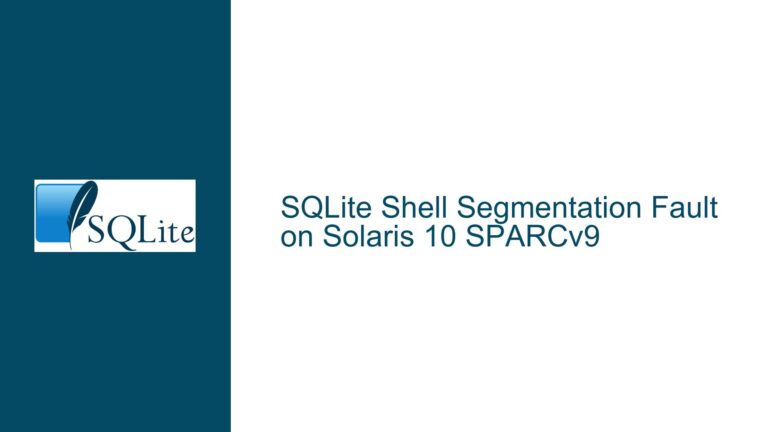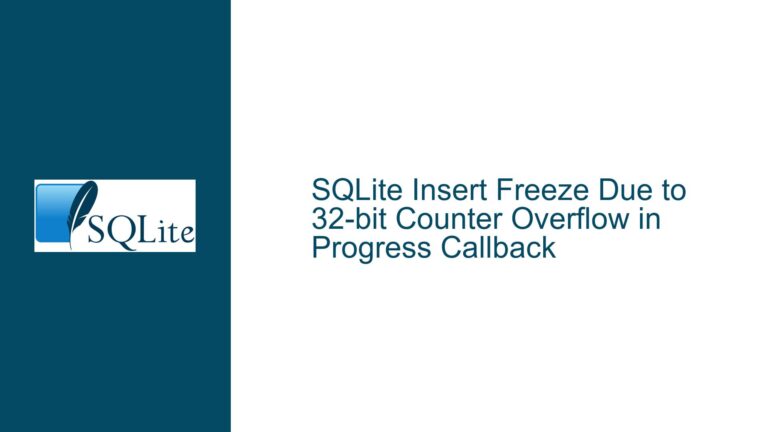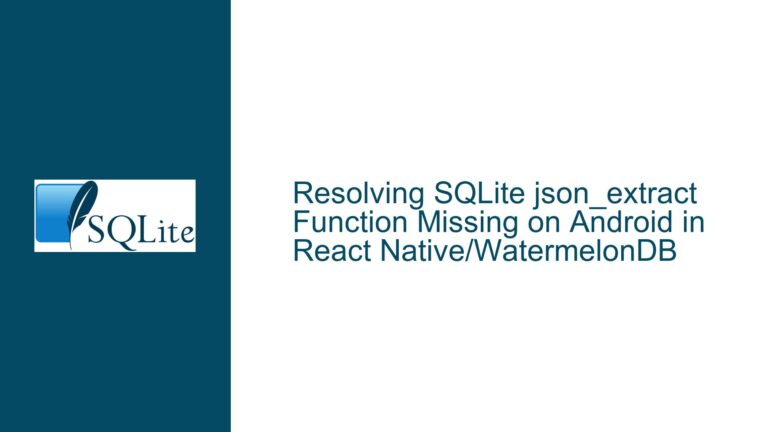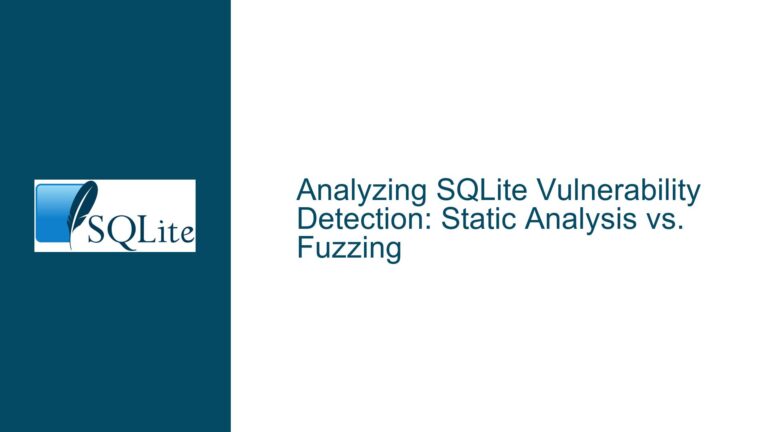Addressing SHA-1 Vulnerabilities and Ensuring Secure SQLite Download Verification
Understanding the Security Risks of SHA-1 and Practical Challenges in SQLite Download Verification
The debate around SQLite’s use of SHA-1 hashes for verifying downloadable artifacts highlights a critical intersection of cryptographic security, practical usability, and infrastructure design. At its core, the issue revolves around whether SHA-1 provides sufficient protection against modern collision attacks and whether alternative hashing algorithms (e.g., SHA-3) address these concerns without introducing new usability challenges. The discussion also exposes broader questions about the purpose of providing hashes for downloads and the limitations of relying on them as a security mechanism. This guide dissects the technical arguments, evaluates the threat landscape, and provides actionable steps for users and developers to mitigate risks.
Evaluating the Threat Landscape: SHA-1 Collision Attacks and Their Relevance to SQLite
Theoretical Vulnerabilities vs. Practical Exploitation
SHA-1, introduced in 1995, was deprecated by NIST in 2011 due to vulnerabilities exposed by advancements in cryptanalysis. Two landmark attacks—SHAttered (2017) and SHAmbles (2020)—demonstrated practical collision attacks against SHA-1. A collision attack occurs when two distinct inputs produce the same hash output, undermining the integrity of hash-based verification.
- SHAttered: Produced two different PDF files with identical SHA-1 hashes using computational resources equivalent to 6,500 CPU years. While the attack required significant resources, it proved that SHA-1 collisions are feasible for well-funded adversaries.
- SHAmbles: Reduced the cost of collision attacks to approximately $45,000 using optimized GPU clusters, demonstrating that the barrier to entry is lowering over time.
Critics argue that these attacks are impractical for targeting SQLite specifically. The SQLite team initially dismissed concerns, reasoning that:
- Artifact Size: SQLite’s downloadable files (source code bundles, precompiled binaries) are orders of magnitude larger than the PDFs used in SHAttered, increasing the complexity of crafting a collision.
- Deployment Cycle: Frequent SQLite updates would render a collision attack obsolete before it could be deployed.
- Server Compromise Requirement: An attacker would need to compromise SQLite’s servers to replace a legitimate file with a malicious one, at which point altering the hash would be trivial regardless of the algorithm used.
However, these arguments overlook scenarios where hashes are used to verify downloads from third-party mirrors. If a mirror is compromised, a collision attack could allow an attacker to serve a malicious file matching the official SHA-1 hash, bypassing integrity checks.
The Role of Hashes in Trustworthy Distribution
Hashes serve two primary purposes:
- Integrity Verification: Ensuring files are not corrupted during download.
- Authenticity Verification: Ensuring files originate from a trusted source (when hashes are obtained through a separate, secure channel).
The latter is where SHA-1’s weaknesses become critical. If an adversary can generate a collision, they can create a malicious file that matches the hash of a legitimate file, undermining authenticity. This risk is amplified in environments where users rely on mirrors or cached downloads.
Root Causes of Verification Challenges: Algorithmic Weaknesses and Ecosystem Fragmentation
Algorithmic Limitations of SHA-1
SHA-1’s 160-bit output is insufficient to resist brute-force attacks with modern computing power. While collision resistance is its primary weakness, the algorithm also lacks robustness against length-extension attacks, though these are less relevant for file verification.
Usability Barriers with SHA-3 Adoption
SQLite’s migration to SHA-3-256 addressed cryptographic concerns but introduced usability issues:
- Tooling Fragmentation: Native support for SHA-3 varies across platforms. Windows lacks built-in tools for SHA-3 verification, forcing users to rely on third-party utilities like OpenSSL or Fossil. Managed environments often restrict software installations, complicating access to these tools.
- User Awareness: Many users are unaware of how to verify SHA-3 hashes or lack the technical expertise to install additional software.
Architectural Limitations of Hash-Based Verification
Hosting hashes alongside downloadable files on the same server undermines their security value. If an attacker compromises the server, they can replace both the file and its hash, rendering verification meaningless. This centralizes trust in the server’s security posture rather than distributing it through cryptographic means.
Mitigating Risks: Cryptographic Best Practices and Workarounds for Secure Verification
Migrating to Stronger Hashing Algorithms
- Adopt SHA-3-256 or BLAKE3: These algorithms offer resistance to collision and preimage attacks. SHA-3’s sponge construction makes it inherently resilient to many cryptographic vulnerabilities.
- Provide Multiple Hashes: Offering both SHA-3-256 and SHA-256 allows users to choose based on their tooling constraints. While SHA-256 is theoretically weaker than SHA-3, it remains secure for most practical purposes and is widely supported.
Workarounds for Windows Users
- Fossil SCM: The Fossil executable includes a
sha3sumcommand and can be run without installation. Example:fossil sha3sum sqlite-amalgamation-3430000.zip - OpenSSL Third-Party Builds: Precompiled Windows binaries for OpenSSL (e.g., from Shining Light Productions) enable SHA-3 verification:
openssl dgst -sha3-256 sqlite-tools-win32-x86-3430000.zip - PowerShell Scripts: Users with execution rights can implement a SHA-3 script using .NET libraries (requires PowerShell 5.1+):
Add-Type -AssemblyName System.Security $hasher = [System.Security.Cryptography.SHA3_256]::Create() $fileStream = [System.IO.File]::OpenRead("sqlite-dll-win64-x64-3430000.zip") $hashBytes = $hasher.ComputeHash($fileStream) $hashString = [System.BitConverter]::ToString($hashBytes).Replace("-", "").ToLower() Write-Output $hashString
Enhancing Verification Architecture
- Distribute Hashes Through Separate Channels: Publish hashes on a different domain, via a mailing list, or through a public log (e.g., Certificate Transparency). This reduces the risk of simultaneous compromise.
- Digital Signatures: Sign downloadable artifacts with a private key, and distribute the public key through trusted channels (e.g., OS key stores). This shifts trust from the hash algorithm to the cryptographic signature.
Enterprise Solutions
- Paid Support Contracts: Enterprises can engage with SQLite’s professional support team to receive artifacts through secure channels (e.g., encrypted email, signed packages).
- Internal Mirrors with Policy Enforcement: Host internal mirrors that enforce hash verification and signature checks before serving files to users.
User Education and Documentation
- Step-by-Step Guides: Provide platform-specific tutorials for verifying hashes using common tools (e.g., OpenSSL, CertUtil, PowerShell).
- Clear Warnings: Document the limitations of hash-based verification and advocate for supplementary measures like code signing.
Conclusion: Balancing Security and Practicality in Artifact Verification
The transition from SHA-1 to SHA-3 reflects necessary progress in cryptographic hygiene, but it also highlights the tension between theoretical security and real-world usability. For SQLite users, the immediate priority is adopting SHA-3 verification using workarounds where necessary, while advocating for architectural improvements like separate hash distribution and digital signatures. Developers must recognize that security is a layered endeavor—no single mechanism (including hashes) suffices in isolation. By combining stronger algorithms with robust distribution practices and user education, the ecosystem can mitigate risks without sacrificing accessibility.
